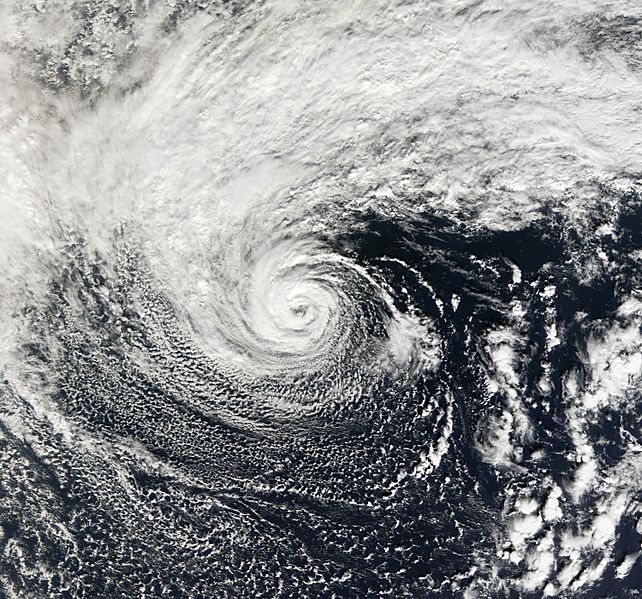Image: Storm 91C 01 nov 2006 2030Z

Description: Tropical storms, as their name suggest, tend to form in the tropics. However, from time to time similar looking storms can form at higher latitudes. Extratropical storms have cold rather than warm cores and usually form their characteristic spiral shape when two fronts collide. More rare are polar lows, a similar storm system which can form in the Arctic. On very rare occasions, however, there are peculiar hybrid storms with some of the characteristics of a tropical storm and some characteristics of an extratropical storm. The terminology to describe them becomes potentially confusing. One name given to such storms is subtropical storms. This photo-like image of a subtropical storm was acquired by the Moderate Resolution Imaging Spectroradiometer (MODIS) on the Terra satellite on November 1, 2006. Located 900 miles off the coast of Oregon in the northwestern Pacific, this storm system looks like a hurricane, but it is located far from any of the typical hurricane formation areas. The storm originally formed from a cold-cored extratropical storm, but after sending two days over anomalously warm water, it developed a warm center and the hurricane characteristics of a cloud-free eye and an eyewall of thunderstorms circling the eye. Though the storm was strong enough to be named had it formed in one of the hurricane sectors, it is outside the regions which hurricane monitoring organizations administer, so the authority to give it a full name is not well defined. As of November 2, 2006, the Central Pacific Hurricane Center in Honolulu had not issued any information on the storm nor even applied it with a name. It was known merely as Storm 91C by the U.S. Navy.
Title: Storm 91C 01 nov 2006 2030Z
Credit: http://earthobservatory.nasa.gov/NaturalHazards/natural_hazards_v2.php3?img_id=13951
Author: NASA image by Jesse Allen, Earth Observatory, using data provided courtesy of the MODIS Rapid Response team at Goddard Space Flight Center.
Permission: This file is in the public domain in the United States because it was solely created by NASA. NASA copyright policy states that "NASA material is not protected by copyright unless noted". (See Template:PD-USGov, NASA copyright policy page or JPL Image Use Policy.) Warnings: Use of NASA logos, insignia and emblems is restricted per U.S. law 14 CFR 1221. The NASA website hosts a large number of images from the Soviet/Russian space agency, and other non-American space agencies. These are not necessarily in the public domain. Materials based on Hubble Space Telescope data may be copyrighted if they are not explicitly produced by the STScI.[1] See also Template:PD-Hubble and Template:Cc-Hubble. The SOHO (ESA & NASA) joint project implies that all materials created by its probe are copyrighted and require permission for commercial non-educational use. [2] Images featured on the Astronomy Picture of the Day (APOD) web site may be copyrighted. [3] The National Space Science Data Center (NSSDC) site has been known to host copyrighted content even though its photo gallery FAQ states that all of the images in the photo gallery are in the public domain.
Usage Terms: Public domain
License: Public domain
Attribution Required?: No
Image usage
The following 3 pages link to this image:

